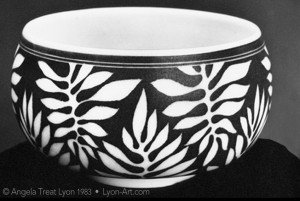Recently I was interviewed for EnkoArt.wordpress.com, a terrific art site that features many artists. Mia Corrino, the interviewer, does a whole lot of research before asking her questions, and I was particularly pleased with the questions she asked me. Here’s the first one – more to come in ensuing posts. Or if you so choose, you can read the whole thing on her site HERE.
Question 1:
Angela, you have a great, resourceful website that will answer probably most of the questions one might have about your artistic journey. You mentioned that the older you get, the looser your work is. I want you to develop this thought a little bit more for me. What is it caused by? [I think I would ask, ‘what is important about that,’ instead—just a thought.]
ANGELA:
I was a potter for 15 years, starting out as a regular cup and plate maker.
 But within a short time it became obvious that in order to compete, I had to choose between being a potter who made hundreds of ordinary, inexpensive utilitarian pots, or a fine art potter who did unique work for high dollar.
But within a short time it became obvious that in order to compete, I had to choose between being a potter who made hundreds of ordinary, inexpensive utilitarian pots, or a fine art potter who did unique work for high dollar.
I chose the high end, because I loved etching, carving and painting beautiful designs on my pots. Each one was unique. Every little line, every placement of color had to be ‘just so,’ or I’d be displeased and throw the work out. I wish I had some of those pieces now—they were probably 100 times better than I thought they were!
Soon, though, I discovered that I’d better work faster in order to make enough pots to make a living, so it automatically happened that I started loosening up. I trashed fewer pots and allowed more “mistakes” through, and ironically, the feedback was that my work was getting better! “Go figure,” I thought.
CAR WRECK CHANGES EVERYTHING
I was in a very serious car wreck in ’81 and everyone (but me!) thought I’d never walk or work as a potter again. How wrong they could be—I was up on my feet in 8 weeks with the help of an awesome chiropractor, who gave me the best advice ever: he said, “Do it, let it be.” So I started making pots again, and letting them be. And they were great.
Then when I switched to carving stone, “do it, let it be” became my mantra more than ever, because I had no idea what I was doing, really, but somehow what I created, people loved.
I still fight the “do it just so” voices when I carve, but especially in my painting. Just last week I over-painted what would have been a very powerful painting, but it became just a piece of sentimental blah. Should have just let it be. It lost its intrinsic power—I’ve already painted over it.
Now that I’m close to 70 and have been carving for 35 years, it’s become paramount to me to heed the “let it be, stop, NOW!” voice, and to let the looseness occur by itself. After doing something for years and years, your body knows more than you do, and connects with your inner wisdom way better than your conscious mind does, and will give you the powerful result you want. Ignore it and see the piece die before your eyes in one stroke.
TRUST THE ‘JUST DO IT’ INSTINCT
You have to allow your hands to fly faster than your eyes can track—it’s almost like being in a blind trance I come out of after a while. I stand back and look at what I did, and it’s almost like a miracle to me—I’ll exclaim, “wow! I did that?”
You have to have the clarity to see when the work is actually saying what you wanted it to say, and to stop. Right now. Whether or not YOU call it done compared to the envisioned, complete painting you have in your head. But if it carries the message, and has the desired energy, and it’s only what you used to call half-done, you have to respect that. It’s about the energy, not the perfection.
When you see that a piece speaks, pops, is as powerful as you wanted it to be, or sometimes even more powerful—from then on, you have to be diligent to only make micro changes, like the nano-minimal cleaning up of minor distracting parts, pieces or lines.
RESTRAINT!
You have to have the restraint to keep yourself from over-painting or over-carving. Overdoing is like blathering on in your writing when your first paragraph knocked your reader over. You wreck your impact by incessant blather. Let the inner wisdom of the voice of the artwork speak through what you used to call imperfections and wayward lines, colors and forms.
That’s why I say that I love what I do. Because in truth, I’m an abject coward and would never do the scary things people do like hang gliding or even skate boarding! But! I know how to walk the razor’s edge between creating blathery art, and powerful, impactful paintings and sculpture that will continue to have impact for centuries after I’m gone. What a thought!
…to be continued….
